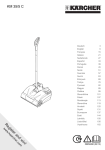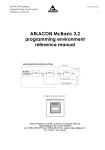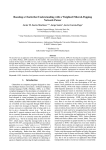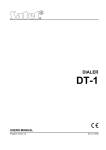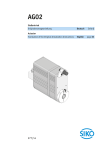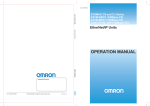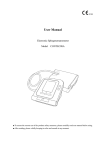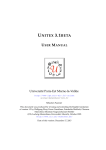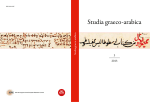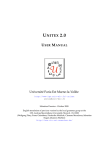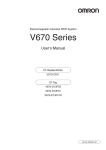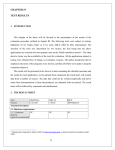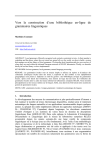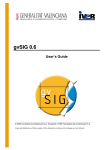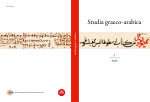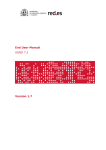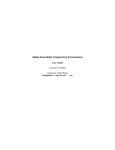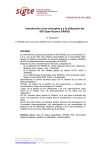Download Production of morphological dictionaries of multi
Transcript
Production of morphological dictionaries of
multi-word units using a multipurpose tool
Ranka Stanković and Ivan Obradović
Cvetana Krstev
Duško Vitas
University of Belgrade — Faculty
of Mining and Geology, Djušina 7,
11000 Belgrade, Serbia
Email: {ranka,ivano}@rgf.bg.ac.rs
University of Belgrade — Faculty
of Philology, Studentski trg 3,
11000 Belgrade, Serbia
Email: [email protected]
University of Belgrade — Faculty
of Mathematics, Studentski trg 16,
11000 Belgrade, Serbia
Email: [email protected]
Abstract—In this paper we outline the use of the multipurpose
software tool LeXimir in our approach to automated production
of lemmas for e-dictionaries of multi-word units. Development of
morphological dictionaries of MWUs is a tedious task, especially
in the case of Serbian and other languages featuring complex
morphological structures. After realizing that the development
of such a dictionary manually is an extremely slow process, we
endeavored towards a procedure aimed at automated production
of MWU dictionary lemmas, which is also outlined in this
paper. The procedure was subsequently implemented as a new
functionality of LeXimir, and makes use of our comprehensive edictionaries of Serbian simple words. We present an evaluation of
the performance of this functionality, and hence of our procedure,
obtained from experiments on two types of data. Finally, we
discuss some further possible applications of our procedure and
LeXimir in language processing tasks.
various approaches to lexical treatment of multi-word units
(MWUs) that were analyzed in detail by Savary [6]. Productive
classes of MWUs, like numerals and various named entities
that rely on them (e.g. measurement phrases) can best be
described by dictionaries in the form of finite-state transducers
(FST), and a number of them were produced for Serbian
as well [7]. Other contiguous MWUs that are idiosyncratic
in nature, namely nouns and adjectives, have to be lexically
described in a similar way as simple words. That means that
a dictionary of MWU lemmas (DELAC) that is provided
with information enabling the production of all inflected
forms (DELACF) has to be developed. In practice this simple
procedure is not easy to perform because MWU lemmas have
to be collected, generated, and inflected.
I. I NTRODUCTION
M
ORPHOLOGICAL electronic dictionaries of Serbian
for natural language processing (NLP) are being developed for many years now. Their development follows the
methodology and format (known as DELAS/DELAF) presented for French in [1]. E-dictionaries in the same format
have been produced for many other languages. This format
can be briefly described in the following way: in a dictionary
of lemmas (DELAS) every lemma is described in full detail so
that a dictionary of forms containing all necessary grammatical
information (DELAF) can be generated from it. The dictionary
of forms is used in NLP tasks. Two corpus processing systems
that support work with this dictionary format were developed,
Unitex [2] and Nooj [3], both of which use finite-state technology as initially introduced in [4]. Serbian e-dictionaries
of simple forms have reached a considerable size: they have
a total of more than 126,000 lemmas [5] generating more
than 4.3 million forms. Unitex official web site contains a
comprehensive list of references related to the production and
usage of e-dictionaries for various languages while Unitex
distribution contains large samples of e-dictionaries, including
one for Serbian which covers a sample text, the Serbian
translation of Voltaire’s Candide.
Some multi-word compounds composed of two or more
contiguous graphical words that show some degree of noncompositionality and have constant references can be described using a similar approach. The NLP community offered
II. I NFLECTION OF MWU S
In order to produce a list of MWU forms in a systematic
way, it is necessary to decide what the lemma of all these
forms is, what are its additional features, how do its simple
word constituents inflect, and what is the inflectional behavior
of a MWU as a whole. One can imagine that for some
languages this complex procedure can be skipped and a
list of MWU forms can be produced from scratch. Serbian
is, however, like all Slavic languages a highly inflectional
language and such a shortcut procedure cannot be applied.
We will illustrate this with one example. The nominal MWU
petokraka zvezda ‘five-pointed star’ consists of an adjective
followed by a noun, which in Serbian is the natural order of
an adjective and a noun in a MWU. However, this MWU,
together with a few more allows a reverse order as well —
zvezda petokraka. It is more often used in the singular, but it
can be used in the plural as well. In Serbian, adjectives and
nouns inflect in number and case, while adjective forms also
depend on the gender, definiteness, comparison, and in some
cases animacy. Adjectives and nouns do not inflect freely in
a MWU — the values of categories for number, case and
gender have to agree. The animacy is important only for the
masculine gender nouns in the accusative singular, and since
the gender of zvezda ‘star’ is feminine, the animacy is of no
relevance for this MWU. Finally, as the adjective petokrak
‘five-pointed’ has no comparative and superlative forms, and
Fig. 1.
A simplified transducer NC
petokraka zvezda and kvadratni metar
AXN r
for compounds of the type
definite and indefinite written adjective forms for feminine
gender coincide, definiteness is of no relevance either.
This example illustrates the complexity of capturing all
information about one MWU in its DELAC lemma. The most
demanding part is to formulate the agreement conditions in
a consistent way. A special form of inflectional transducers
developed by Savary [8] and implemented in the Multiflex
system answers most of these questions. The inflectional
graph in Fig. 1 illustrates this. A MWU serving as lemma
is tokenized and its tokens become values of variables, in our
case $1=petokraka, $2=<space>, $3=zvezda. If a pattern of
the form <$i > appears in the inflectional graph it means that
the corresponding token is recopied in all MWU inflectional
forms as it is — in our example a second token, a space, is
reproduced in all inflectional forms.
A token pattern can be followed by one or more equations of the type Grammatical feature=value. In that case a
specific form of a token is needed. In our example a token
<$3:Gen=m;Nb=s;Case=4> from the lower part of the graph
means that the masculine gender, singular and accusative form
of the third token — the noun zvezda — is needed. However,
the gender of the noun zvezda is feminine, so this form cannot
be produced and the lower paths in the graph will be ignored.
They will not be ignored for some other MWUs, like kvadratni
metar ‘square metar’, since the gender of metar is masculine.
Additionally, grammatical-feature equations can contain not
only concrete values but also unification variables. A unification variable instantiates to all values of the corresponding
grammatical feature. For Serbian, a pattern <$3:Case=$c>
means that forms for all cases — 7 different values — will
be generated for the third token. The occurrence of the same
unification variables in the same path means that their values
have to agree. If a pattern <$1:Case=$c> appears in the same
path as <$3:Case=$c> it means that when the genitive form
of the first token is generated then the genitive form of the
third token has to be generated as well, and that will also be
the value of the ‘Case’ feature of the generated MWU form
— the output of the transducer.
Finally, a unification variable does not need to instantiate to
all values of some grammatical feature. Instead, it can inherit
its value from a token itself. In the pattern <$3:Gen==$g>
the variable $g inherits its value from the third token zvezda
and instantiates only to the value f — the feminine gender.
The variable $g from the pattern <$1:Gen=$g> occurring in
the same path will thus have to agree with it and take the same
value.
The two possible orders of the adjective and the noun in
the MWU are achieved with two separate paths in the graph,
one for the order given by a lemma itself, and the other for
the reverse order. The orthographic variants of MWUs, e.g.
the optional use of a hyphen, as well as omission of some of
its constituents can be easily described using Multiflex graphs
[9]. The Multiflex system is incorporated into Unitex, but it
was also successfully used for Polish proper names in another
environment [10].
By analogy with entries in a dictionary of simple word
lemmas, an entry in a DELAC dictionary consists of a MWU
lemma to which a name of an inflectional transducer (similar
to the one represented in Fig. 1) is assigned. Similarity ends
here, because simple word constituents of a MWU lemma also
have to be described in a way that enables the production of
all needed forms. This leads finally to the following lemma
form:
petokraka(petokrak.A6:aefs1g)
zvezda(zvezda.N600:fs1q),NC_AXNr
This DELAC entry enables the production of 32 MWU
forms for DELACF, one of which, representing the genitive
singular with reverse order of constituents is:
zvezde petokrake,petokraka zvezda.N:fs2q
Production of a lemma in the format presented is far too
demanding to be done manually because for each MWU one
has to provide the following information:
1) What is the lemma? petokraka zvezda.
2) How does this MWU inflect and which inflectional transducer should be used for it? N AXNr.
3) Which MWU constituents inflect? petokraka and zvezda.
4) What are DELAS entries of these MWU constituents
that enable the generation of all needed forms?
petokrak.A6 and zvezda.N600.
5) What are the values of grammatical features of constituent
forms used in the MWU lemma? aefs1g and fs1q.
The manual production of a lemma is, however, not necessary because possible answers to the above questions that
concern MWU constituents can be found in dictionaries of
simple words.
III. L E X IMIR AS A D ICTIONARY M ANAGEMENT S YSTEM
Bearing in mind the aforementioned complexity of production of MWU lemmas we have endeavored towards a procedure for automatic production of DELAC entries. The software
tool which enabled the implementation of this procedure was
Fig. 3.
Fig. 2.
Components of the software tool LeXimir
LeXimir, 1 a multipurpose tool developed by the University of
Belgrade Language Technology Group [11] to support computational linguists in developing, maintaining and exploiting
e-dictionaries. LeXimir is written in C#, and operates on the
.NET platform. It can run on any personal computer under
Windows and supports simultaneous manipulation of various
language resources: e-dictionaries, wordnets, and aligned texts.
Implementation of LeXimir followed a modular approach.
Namely, there exists a common core of the system, which
is coupled with several modules performing different tasks.
The central part of the system is LeXimir Core composed
of several .Net libraries: CommonRes.dll, NlpQuery.dll, VisualTMX.dll and WNDictAuto.dll (Fig. 2). For communication
with lexical resources LeXimir makes use of the NlpQuery.dll
module.
Modular organization of components provides two obvious
benefits. In the first place, it enables the use of various
resources in any part of the system, wherever they are needed.
Thus, for example, morphological dictionaries can be used
for adding additional morphological information to wordnet
synsets, whereas both morphological dictionaries and the
wordnet can be used in production of concordances for aligned
1 LeXimir is available under CC NC BY licence. For more information see
http://korpus.matf.bg.ac.rs/soft/LeXimir.html
LeXimir’s editor for MWU dictionaries
texts. On the other hand, it enables the use of LeXimir Core
in different scenarios: as a stand alone Windows application
LeXimir.exe or as a web application VeBrana.aspx2 , also
known as VeBrana (previously WS4QE), which is supported
by the wsQueryExpand.asm web service. The web service
accepts and generates data sets in XML form, which are
further converted into data structures that can be used for
different purposes (string, array, table, etc.). As examples of
web service functions we will mention a few characteristic
ones: getObliciLeme(lema), which generates inflected forms
for a given lemma, getSinonimiWN WithFlex(lema), which
returns all synonyms from a given wordnet synset in all
inflected forms, and getSinonimiWN NoFlex(lema) which returns synonyms without inflected forms.
As our e-dictionaries are Unitex-based, and Unitex is an
open source software distributed under the LGPL license, we
incorporated its modules in LeXimir for the majority of tasks
that involve manipulation of e-dictionaries. For the production
of MWU DELAC lemmas we used the appropriate Unitex
modules for dictionary look-up.
LeXimir provides for concurrent manipulation of several
dictionaries of lemmas, both of simple words and MWUs
(DELAC), distributed in any number of files. However, the
possibility of manipulating dictionaries of word forms is not
envisaged, as such files are produced automatically either from
DELAS or DELAC by means of appropriate FSTs. Organizing
dictionaries in sets of different files is practically motivated.
Namely, smaller size files are much easier to manipulate.
LeXimir’s editor for MWUs is illustrated in Fig. 3. Besides
the usual functions — add, insert, copy, change — a user
can check the correctness of every lemma with the function
‘Inflect’ that lists all inflected forms of a selected lemma.
Another useful function is the extraction of subsets of lemmas
based on different criteria: lemmas’ beginning, their part of
2 http://hlt.rgf.bg.ac.rs/VebRana
Noun/noun (both inflect and agree in number and case)
Noun/noun in the genitive (only the first noun inflects)
• Word/noun (only the second noun inflects; the first word
is usually not a Serbian simple word)
• Noun/adjective (both inflect and agree in gender, number
and case)
However, there are 25 different inflectional graphs for
the nominal MWUs with two constituents because there are
subtleties that have to be taken into consideration besides these
basic structures, e.g. can a MWUs have plural forms, can a
separator be omitted or replaced by another separator, etc.
The basic structure, however, determines the general form of
a lemma and information that has to be supplied.
Thus, automatic production of the lemma for petokraka
zvezda could proceed like this: a look-up in the dictionary of
simple word forms determines that zvezda can only represent
two realizations of the noun lemma zvezda, namely in the
nominative singular or in the genitive plural. Similarly, it
is determined that petokraka can be one of 12 different
representations of the adjective petokrak; however, only one
of them agrees with the noun zvezda, and that is the singular,
feminine gender, nominative case form. Consequently, it can
be deduced that only the basic structure adjective/noun applies
here.
Of course, not all MWUs are so easy to process. For instance, for the MWU vojna tajna ‘military secret’ a dictionary
look-up offers the following possibilities:
•
•
Fig. 4.
The DELAC entry management form of Leximir
speech (PoS), inflectional class code, syntactic and/or semantic
markers or a Boolean combinations of these criteria.
Figure 4 shows the table for manual production of a DELAC
entry having two constituents: petokraka and zvezda. A user
can insert constituents of a MWU in the column ‘Form’ of
the table. In the next step columns ‘Lemma’, ‘FST’ (PoS and
inflectional codes of constituents), and ‘GramCat’ (grammatical codes of constituents) have to be filled. The system does
this automatically by offering all possible solutions retrieved
from DELAS dictionaries of simple words. In the third step,
the selection of the correct lemma, FST code and grammatical
categories is supported by the possible combinations offered
in auxiliary tables (in the right bottom corner of Fig. 4). In
the final step, the user has to fill manually the code of the
inflectional transducer for the newly produced MWU lemma,
and attach to it the appropriate semantic and other markers.
A user can then check the correctness of the new MWU
lemma by using the ‘Inflect’ function that invokes Multiflex
to perform the inflection.
The outlined procedure does help in answering the two last
questions posed at the end of section II. However, answers to
questions 2 and 3 have to be provided by the user. Thus, by
following this approach not more than 2800 DELAC entries
were produced during three years, which we found very
ineffective.
IV. A RULE BASED P ROCEDURE FOR I NFLECTION OF
MWU S
A. Detection of inflectional properties of MWU lemmas
We have further improved the procedure for production of
MWU lemmas when we realized that the answers obtained
automatically in support of manual production of MWU
lemmas can also help in detection of the syntactic composition
of a MWU and therefore indicate the appropriate inflectional
transducer. Namely, the MWUs in Serbian have predictable
basic structures. For instance, nominal MWUs with two constituents (beside a separator) fall into five basic structures:
• Adjective/noun (both inflect and agree in gender, number
and case)
vojna
vojna
tajna
tajna
vojni
vojna
tajna
tajni
‘military’
‘war’
‘secret’
‘secret’
A
N
N
A
nom.,
nom.,
nom.,
nom.,
sing.,
sing.,
sing.,
sing.,
f.
f.
f.
f.
Thus there are three possible MWU structures: adjective/noun, noun/noun and noun/adjective, whereas only the first
one is correct.
Based on an analysis illustrated by the previous example,
we have developed a new functionality within LeXimir that
offers one or more DELAC entries for every MWU presented
in its lemma form. As indicated by the example, it relies
on information in e-dictionaries of simple words, but also
uses a set of manually produced rules to deduce the basic
structure of a given MWU, as well as its additional features.
For the example vojna tajna this functionality would offer
three lemmas; the first one would be selected, the other two
discarded:
vojna(vojni.A2:aefs1g) tajna(tajna.N6:fs1q)
AXN
vojna(vojna.N6:fs1q)
tajna(tajna.N6:fs1q)
NXN
vojna(vojna.N6:fs1q)
tajna(tajni.A5:aefs1g) NXA
In order to design our automated procedure we grouped
all inflectional transducers into equivalence classes or superclasses: a super-class consists of all MWUs having the same
basic structure. It also means that their forms of MWU lemmas
are the same because they need the same information for the
production of inflectional forms. This is also reflected in the
convention we used for naming the inflectional transducers:
A stands for an adjective constituent, N stands for a noun
TABLE I
S UPER - CLASS AXN
Class
AXN
AXN3
AXNF
Example
vojna tajna
Ajfelova kula
duhovni vodja
AXNr
petokraka zvezda
TABLE II
XML FORM OF A RULE FOR THE CLASS NC AXN3,
NC AXN
SUPER - CLASS
Specifics
does not inflect in number
second constituent changes
gender in plural forms
allows reverse order
constituent, X stands for a constituent that does not inflect
(including a separator), with some additional digits and letters
added to differentiate transducers. This is illustrated in Table I
by four classes (names of inflectional transducers) all belonging to the same AXN super-class and used for the inflection of
MWUs consisting of an adjective followed by a noun, where
both constituents inflect and must agree in basic grammatical
categories.
In order to formulate a strategy for the production of MWU
lemmas we analyzed the data available in the existing DELAC
dictionary looking for useful information. On the one hand, we
identified the additional information assigned to components
of MWUs belonging to a particular inflectional class, and on
the other, we identified inflectional classes associated with the
same additional information.
B. The rule design strategy
The procedure for automatic construction of a DELAC type
dictionary relies on a manually produced set of rules. The
rule design strategy resulted from the aforementioned expert
analysis of available MWU lemmas. The task of the rule based
procedure is to automatically generate the complete MWU
lemma. However, the strategy and the procedure are independent, and changes in the strategy, in general, do not affect the
procedure itself. This approach enabled us to experiment with
various rule strategies, and thus the final strategy used is a
result of several iterations.
Our rule based strategy presently consists of 99 rules — 79
for nouns and 20 for adjectives. Among them, 33 rules are
for MWUs with 2 components, 34 rules for MWUs with 3
components, 19 rules for MWUs with 4 components, 8 rules
for MWUs with 5 components, and 5 rules for MWUs with 6
and 7 components. Examples of two rules are given in Tables
II and III.
Conditions defined for each rule are of two types: conditions
that specify grammatical categories of MWU components
and usually apply to components that inflect, and additional
conditions related to semantic and/or syntactic markers of the
components. The rule in Table II applies to two-component
MWUs, in which the first component is an adjective, the
second component is a noun, and the MWU does not inflect
in number.
This rule is applied as follows: if the first component
satisfies (according to the dictionary of simple words) the
specified grammatical conditions, namely, that it is an adjective
in the nominative case, and the second component also satisfies
(according to the dictionary of simple words) the specified
<R u l e ID = ‘2 ’ CFLX= ‘NC AXN3 ’ C f l x G r o u p = ‘NC AXN ’>
<RuleGenCond>
<Word ID = ‘1 ’ POS= ‘A ’ F l e x = ‘ t r u e ’
Case = ‘1 ’ Anim = ‘$ a ’ Gen = ‘$ g ’ />
<Word ID = ‘2 ’ POS= ‘N ’ F l e x = ‘ t r u e ’
Case = ‘1 ’ Anim= ‘=$ a ’ Gen = ‘=$ g / >
</RuleGenCond>
<RuleSpecCond ID = ‘1 ’ Example = ‘ A j f e l o v a k u l a ’>
<Word ID = ‘1 ’ Num= ‘ s ’ Cond = ‘$PRE ’ />
<Word ID = ‘2 ’ Num= ‘ s ’ />
</ RuleSpecCond > <RuleSpecCond ID = ‘2 ’
Example = ‘ p o l j s k i r a d o v i ’>
<Word ID = ‘1 ’ Case = ‘1 ’ Num= ‘ p ’ />
<Word ID = ‘2 ’ Case = ‘1 ’ Num= ‘ p ’ />
</ RuleSpecCond > <RuleSpecCond ID = ‘3 ’
Example = ‘ p o l j s k o c v e c e ’>
<Word ID = ‘1 ’ Case = ‘1 ’ Num= ‘ s ’ />
<Word ID = ‘2 ’ Case = ‘1 ’ Num= ‘ s ’
SinSem = ‘+VN, + C o l l , + HumColl ’ />
</ RuleSpecCond>
</ Rule>
grammatical conditions, namely, that it is a noun in the
nominative case, and these two components agree in gender
and animacy, then the additional conditions are checked, and
at least one of them needs to be satisfied. In this case it
means that one of the following additional conditions must
be satisfied: the first component starts with uppercase letter
(e.g. Ajfelova kula ‘Eiffel tower’), or both components are
already in plural (e.g. poljski radovi ‘field works’), or the
second component is a collective noun (e.g. poljsko cveće
‘wild flowers’).
Another rule that applies to three-component MWU adjectives in the form of a simple word adjective followed by the
conjunction kao, followed by an animate noun, is given in
Table III. An example is the adjective lukav kao lisica ‘cunning
as a fox’. Adjectives of this type have two plural forms: the
noun component can be either in the singular lukavi kao lisica
or in the plural lukavi kao lisice. This rule has no additional
conditions. Note that in this case the gender of the noun is
of no relevance and it need not agree with the gender of the
adjective. Namely, feminine case nouns, as the generic name
of a zoological species in this case, can be used to describe
masculine case nouns.
C. Software implementation
To manipulate the strategy in the form of a XML document
our tool LeXimir relies on W3C standard languages Xquery
and XSLT supported by .Net. The user interface for automatic
production of DELAC lemmas is very straightforward and
easy to use. A user can choose a file with a prepared list
of MWUs and a file with a strategy, and the results will be
presented to him in the form of a table (see Fig. 5) in which
the user has only to check the correct solutions upon which a
list of DELAC entries is produced.
Figure 5 depicts the resulting table for a list of 8 MWUs.
TABLE III
XML
FORM OF A RULE FOR THE CLASS
AC A3XN2, SUPER - CLASS
AC A3XN
<R u l e ID = ‘153 ’ CFLX= ‘AC A3XN2 ’ C f l x G r o u p = ‘AC A3XN ’>
<RuleGenCondExample = ‘ l u k a v kao l i s i c a ’>
<Word ID=” 1 ” POS= ‘A ’ F l e x = ‘ t r u e ’
Case = ‘1 ’ Num= ‘ s ’ Gen = ‘m’ />
<Word ID = ” 2 ” POS= ‘MOT’ F l e x = ‘ f a l s e ’
Cond = ‘= , kao ”/>
<Word ID = ” 3 ” POS= ‘N, A ’ F l e x = ‘ t r u e ’
Case = ‘1 ’ Num= ‘ s ’ Anim= ‘ v ’ />
</RuleGenCond>
</ Rule>
Fig. 5.
The Implementation of the Strategy on the prepared list of MWUs
The options offered by the strategy for the first MWU, Avogadrov broj ‘Avogadro’s number’, are far from the correct solution, due to the fact that the possessive adjective Avogadrov
is not included in the Serbian DELAS dictionary of adjectives.
As for the second MWU, Novi Beograd ‘New Belgrade (a
municipality of Belgrade)’, the first of the two options offered
by the strategy is the correct solution. For the third MWU,
Stari Grad ‘Old City (a municipality of Belgrade)’ the strategy
offers as much as 6 options, among which the third represents
the correct solution. Such a large number of options offered
is due to the fact that the form grad can represent as much as
three lemmas: city, degree, and hail. Out of the two options
offered by the strategy for the fourth MWU, muva zujara ‘blow
fly’, the first one is the correct one. As for the 5th and 6th
MWUs, otvorena vrata ‘open door (a meeting of parents with
teachers)’ and autobuska linija ‘bus line’ only one solution is
offered for each of them, and it is correct in both cases. Three
possible solutions are offered for the 7th MWU, ledeno doba
‘ice age’, and one of them, the first, AXN, is partly correct.
Namely, the super-class is properly determined, and hence the
lemma form, and what remains is to replace the inflection
transducer by AXN3, as this MWU does not have a plural.
The correction can be made by the user by stating the new,
correct name of the transducer in the last column of this partly
correct solution. The 8th MWU, petokraka zvezda is already in
the dictionary which is evidenced by the fact that the column
‘ClfxDic’, and the following four columns are already filled.
The solution offered by the strategy is almost the same as
the one existing in the dictionary, except for the fact that the
strategy failed to identify that this MWU allows a reversed
order of components, which is a highly exceptional feature.
The option of the user interface to detect MWUs already in
the dictionary is very useful, as it prevents the introduction of
duplicates in the dictionary. In addition to that, it may alert the
user as to the potential shortcomings of the strategy. When all
options offered by the strategy are reviewed, the system will
automatically generate lemmas for the DELAC dictionary. In
some rare cases all rules will fail and a solution — compound
lemma — will not be offered to the user. In that cases a
user will have to produce a lemma consulting the excisting
e-dicitonary, as illustrated in Figure 4. Thus, we obtain an
automated answer to questions 2 and 3 posed at the end of
Section II. Question 1 is answered by the user, who prepares
the list of input lemmas.
There are various debugging tools and preference selections
at user’s disposal. In the strategy development phase the
user can compare the results obtained by the use of various
strategies on the same MWU input list. The user may also
filter the results and obtain only those that differ from the
results obtained by the previous version of the strategy.
LeXimir has been successfully used for languages other
than Serbian and English, namely, for Bulgarian [12]. The
new functionality for production of DELAC entries is also
expected to perform successfully without any modifications
for other languages. The prerequisites are that there exists a
Unitex module for that language including: a dictionary of
simple words in DELAS format, transducers for the inflection
of simple words, the automatically produced dictionary of
simple word forms DELAF, and transducers for the inflection
of MWUs. As mentioned before, most of these conditions
are satisfied for many languages. However, in order to apply
this functionality to a new language it would be necessary
to develop a new language-dependent strategy, that is, a new
XML document. It is also worth mentioning that the system
can be easily modified to work with formats of simple words
dictionaries other than those supported by Unitex. To that end,
only the dictionary look-up module would have to be changed.
D. Procedure Evaluation
In order to evaluate the performance of LeXimir’s functionality for automated generation of MWU lemmas, and hence
our procedure and our strategy, we have performed experiments on two types of data. The first set of data consisted of
nouns and adjectives already available in the existing DELAC
dictionaries. The MWU lemmas for dictionary entries were
(re)produced by LeXimir and then compared to the (correct)
dictionary lemmas. The second set of data consisted of MWUs
compiled from several sources, all of them nouns. In both cases
the results produced by the system were validated manually.
In line with the possibility of a “partly” correct solution
that we have recognized in subsections IV-B and IV-C, the
evaluation results were classified as follows:
Fig. 7.
Fig. 6.
Results obtained on the first set of test data (in%)
a) If the system produced the correct lemma and assigned
the correct inflectional class for a given MWU the overall
solution was considered as correct;
b) If the system produced the correct lemma but failed to
assign the correct inflectional class, whereas the assigned
super-class was correct, the overall solution was considered
as partly correct;
c) In all other cases the solution was considered to be incorrect.
As we have already seen, our system can produce more
options among which one can be the correct or partly correct
solution. In both cases, another point of interest for evaluation
was the rank of this (partly) correct option. The most favorable
outcome is obviously that this option is the first one on the
list. In Fig. 6 we illustrate some of the results for the first
set of data (about 2800 existing dictionary entries for nouns
and adjectives). The top part of the figure shows the percent
of correct solutions for nouns and adjectives produced by the
system (case a), the percent of partly correct solutions (case
b), and the percent of incorrect solutions (case c). The bottom
part of Fig. 6 illustrates the rank of the correct solution in
the case of nouns, expressed again in percentages. Namely,
for 86,82% percent of MWUs, when the correct option was
found it was at the same time the first one offered, whereas for
8,93% MWUs it was the second offered. For less than 5% the
correct option was offered at the third or some lower place.
We also performed a more in-depth analysis of the incorrect
solutions produced by the experiment with the first set of data.
This analysis showed that in the majority of cases (80%) the
incorrect solution was due to the fact that one of the MWU
components was not in the dictionary of simple words. This
happened mainly either because one of more components of
a MWU representing a proper name are not words in Serbian,
as in Bab-el-Mandeb, or because some words are used only in
MWUs (like nagazna in nagazna mina ‘landmine’). In both
cases there was no justification for including such words in
dictionaries of simple words. In a much smaller number of
Results obtained on the second set of test data (in%)
cases (20%) the incorrect solution resulted from the system’s
failure to cover a specific MWU structure.
With the second set of test data (nouns collected from
various sources) we proceeded as follows. First we removed
all MWUs that already existed in DELAC which resulted in
a list of approximately 1000 MWUs. We separated the list
into proper names or toponyms (about 20%) and common
nouns (about 80%). The rationale for such an approach was
the fact, indicated by the analysis of the first set of data, that
system performance tends to decrease considerably in the case
of toponyms.
The results illustrated by Fig. 7 confirm the conclusion that
toponyms can be viewed as the system’s week point. Namely,
the system failed to give a correct or partly correct solution
for only 3.62% of common nouns, whereas for toponyms
this percentage amounts to as much as 38.61%. All of the
failures in the case of toponyms resulted from the absence of
one or more of its components from dictionaries of simple
words in Serbian (e.g. in Gornji Tavankut, Tavankut is not
used independently), which is in line with failure causes in
the experiment with the first data set. These lemmas can still
be produced within LeXimir following the manual procedure
presented in Section III.
Evaluation results are discussed in more detail in [13].
V. E XISTING AND F URTHER A PPLICATIONS
The outlined procedure is now in everyday use for the
production of MWU dictionary entries for Serbian. Due to
the new functionality implemented in LeXimir the size of the
MWU dictionary grew from the initial 2800 lemmas to existing
6450 in a relatively short period. We expect this growth rate
to be even greater in the forthcoming period, as many new
MWU lists are being prepared.
The benefits obtained by including the MWU dictionary
in language processing tasks for Serbian are already clearly
visible. Besides the benefits that were to be expected, it has
been already shown that the MWU dictionary can also be very
useful in text disambiguation [14], and further in the parsing
process [15]. We would like to point out another interesting
aspect of MWUs which can be exploited in the processing of
named entities, as the initial phase in information extraction.
Serbian morphological dictionaries and local grammars are
successfully being used for recognition of names of persons
and of various functions they might perform within the society.
Local grammars for recognition of functions can recognize
various syntactic structures but, naturally, not all of them. The
use of MWUs can contribute to the increase of the recall
without further complicating the local grammars. For example,
the local grammar does not recognize the function of the
person acting as specijalni izaslanik UN za pregovore o statusu
Kosova Marti Ahtisari ‘UN special envoy for negotiations on
the status of Kosovo Martti Ahtisaari’ because the addition o
statusu ‘on the status’ is not foreseen by the local grammar.
When pregovori o statusu ‘negotiations on the status’ are
added to the MWU dictionary, the local grammar covers the
aforementioned structure as well.
This example leads us to possible applications related to
inflection of free noun phrases based on the recognition of their
syntactic structure. This idea draws from the assumption that
many free noun phrases (used in search queries, for example)
may have the same syntactic structure as a MWU, and that the
inflectional transducers developed for MWUs could be applied
to inflect free noun phrases as well. For example, in the phrase
kućni aparati prošlogodišnje proizvodnje ‘home appliances
of last year’s production’ our procedure would recognize a
structure that is inflected according to the AXN4X1 pattern adjective+noun that do not inflect in number followed by any
two words that do not inflect at all.
This approach has already been tested in VeBrana [11].
Namely, as the described procedure for production of DELAC
entries was implemented in the core engine of LeXimir it can
be used not only in all parts of LeXimir but also in VeBrana,
which as we have seen, was in a way built “on top” of LeXimir.
This enables expansion of queries submitted to the Google
search engine [11]. The main feature of VeBrana is that it
enables inflection of simple words, MWUs and free phrases
supplied as key-words to Google. The tool relies on Serbian
e-dictionaries, inflection transducers for simple words and
MWUs, and uses Unitex and Multiflex modules for inflection
and dictionary look-up. As for the free phrases that are not in
the MWU dictionary, VeBrana relies on its built-in strategy,
and always chooses the first of the options offered, which is,
as we have seen, the correct one in most cases.
In this context the most interesting issue is the interaction
with the user. The interface for query expansion has several
levels of complexity in both releases (Windows i.e. standalone
and web): the simplest includes only morphological expansion
of a query, a more complex one adds synonyms, and the
most complex level enables the user to expand his/her query
in several ways. For instance, if the initial query is ‘marka’
and a user chooses to semantically expand his/her query with
Serbian wordnet then the system will find, among others,
two synsets with appropriate literals: {marka, zaštitni znak,
brend} ‘trade name’ and {marka, poštanska marka} ‘postage
stamp’. If MWU synset literals are in the DELAC dictionary
(poštanska marka), the system directly produces all inflected
forms, but if the literal is not yet in the DELAC dictionary
(zaštitni znak) then the component for production of DELAC
forms described in Section IV is invoked to detect its structure,
which subsequently generates the inflected forms.
Query expansion in the web environment is implemented
in a similar way, with different levels for expansion details.
VeBrana accepts the query from the user and submits it to the
local web service, which then expands the query and forwards
it to the Google search engine. To that end the Google AJAX
Search API is used, a Java script library which provides for
embedding Google searches into web pages or web applications. The abundance of Google services (Web Search, Local
Search, Video Search, Blog Search, News Search and Book
Search) are used by this library, consisting of simple web
objects aimed at performing “inline” search.
ACKNOWLEDGMENT
This research was supported by the Serbian Ministry of
Education and Science under the grant #III 47003.
R EFERENCES
[1] B. Courtois and M. Silberztein, Dictionnaires électroniques du français.
Paris: Larousse, 1990.
[2] S. Paumier, Unitex 2.1 User Manual, http://www-igm.univmlv.fr/unitex/UnitexManual2.1.pdf, 2011.
[3] M. Silberztein, “Nooj: A Linguistic Annotation System for Corpus Processing,” in Proceedings of HLT/EMNLP on Interactive Demonstrations,
ser. HLT-Demo ’05, 2005, pp. 10–11.
[4] M. Gross, “The use of finite automata in the lexical representation of
natural language,” in Electronic dictionaries and automata in computational linguistics, ser. Lecture Notes in Computer Science, vol. 377.
Springer, 1989, pp. 34–50.
[5] C. Krstev, Processing of Serbian — Automata, Texts and Electronic
Dictionaries. Belgrade: Faculty of Philology, University of Belgrade,
2008.
[6] A. Savary, “Computational Inflection of Multi-Word Units — A Contrastive Study of Lexical Approaches,” Linguistic Issues in Language
Technologies, vol. 1, no. 2, 2008.
[7] C. Krstev and D. Vitas, “Finite State Transducers for Recognition and
Generation of Compound Words,” in IS-LTC 2006, T. Erjavec and
J. Žganec Gros, Eds.
Ljubljana, Slovenia: Institut “Jožef Stefan”,
October 2006, pp. 192–197.
[8] A. Savary, “Multiflex: A Multilingual Finite-state Tool for Multi-Word
Units,” in CIAA, 2009, pp. 237–240.
[9] A. Savary, C. Krstev, and D. Vitas, “Inflectional Non-compositionality
and Variation of Compounds in French, Polish and Serbian, and Their
Automatic Processing,” Bulag — Bulletin de Linguistique Appliquée et
Générale, vol. 32, pp. 73–94, 2007.
[10] A. Savary, J. Rabiega-Wisniewska, and M. Wolinski, “Inflection of
Polish Multi-Word Proper Names with Morfeusz and Multiflex,” in
Aspects of Natural Language Processing, ser. Lecture Notes in Computer
Science, vol. 5070. Springer, 2009, pp. 111–141.
[11] C. Krstev, R. Stanković, D. Vitas, and I. Obradović, “The Usage of
Various Lexical Resources and Tools to Improve the Performance of
Web Search Engines,” in 6th LREC, Marrakech, Marocco, 2008.
[12] C. Krstev, R. Stanković, D. Vitas, and S. Koeva, “E-Connecting Balkan
Languages,” in Proc. of the Workshop on Multilingual Resources, Technologies and Evaluation for Central and Eastern European Languages
— RANLP09, Borovetz, Bulgaria, 2009, pp. 23–29.
[13] C. Krstev, R. Stanković, I. Obradović, D. Vitas, and M. Utvić, “Automatic Construction of a Morphological Dictionary of Multi-Word Units,”
in IceTAL. Reykavik, Iceland: Springer, August 2010, pp. 226–237.
[14] I. Alegria, O. Ansa, X. Artola, N. Ezeiza, K. Nojenola, and R. Urizar,
“Representation and Treatment of Multiword Expressions in Basque,”
in Second ACL Workshop on Multiword Expressions: Integrating Processing, Barcelona, Spain, 2004, pp. 48–55.
[15] E. Wehrli, V. Seretan, and L. Nerima, “Sentence Analysis and Collocation Identification,” in Proc. of the Multiword Expressions: From Theory
to Applications — MWE 2010, Beijing, China, 2010, pp. 28–36.









